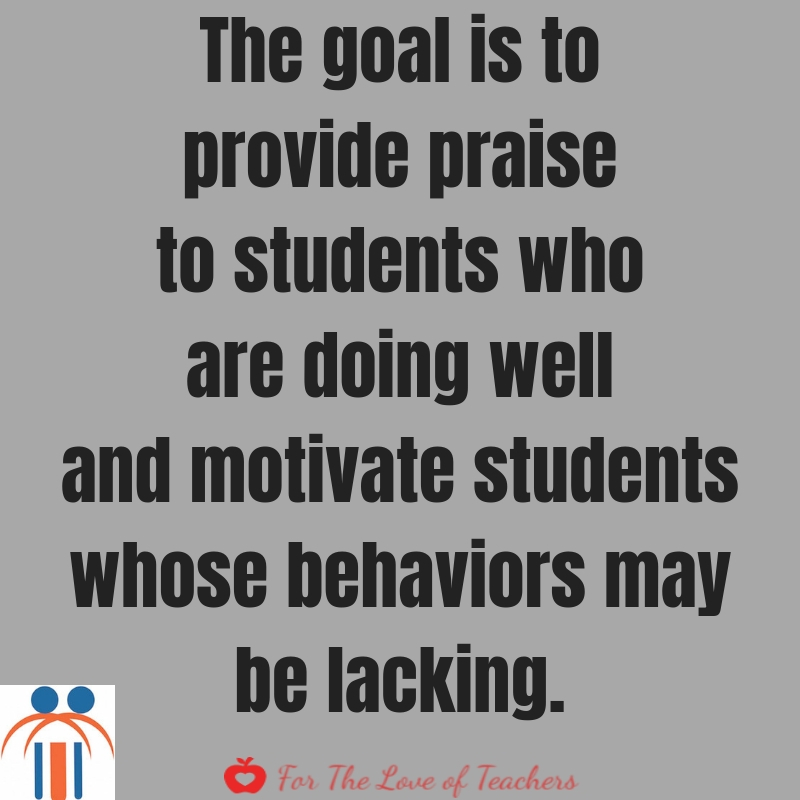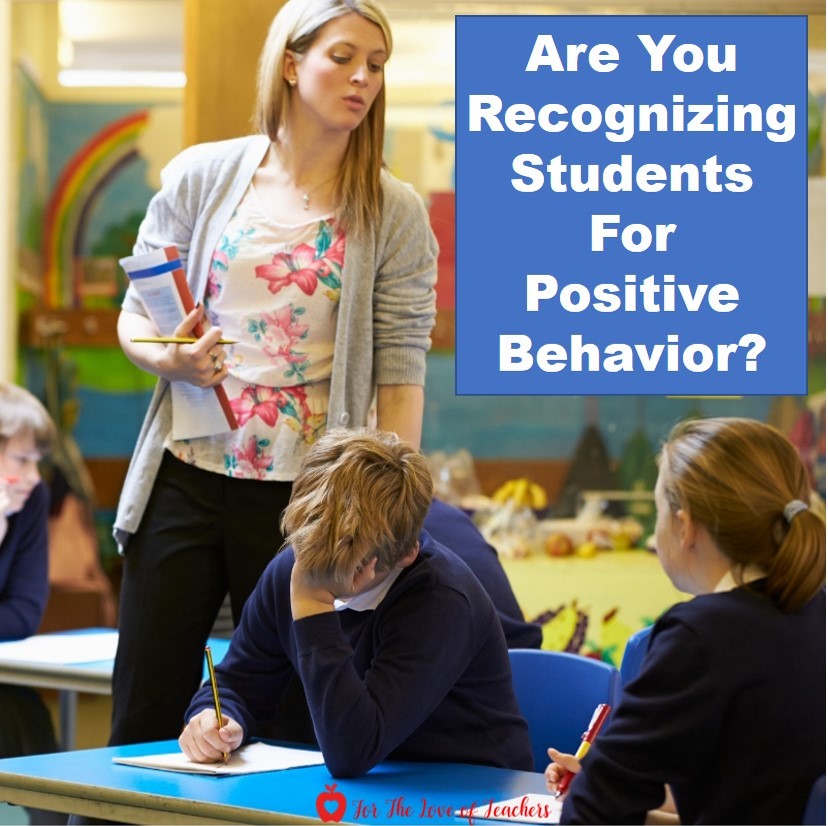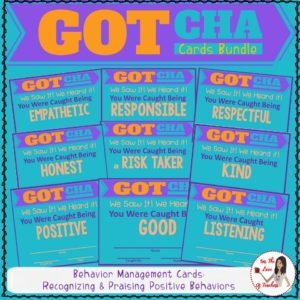Recognizing students for positive behavior, from elementary to middle school and yes, even to high school, goes a long way. Even longer than you may know or realize. According to Thoughtful Teacher, a classroom management model designed to transform the way teachers manage their students says the goal of systematically recognizing positive behavior is “to provide praise to students who are doing well and motivate students whose behavior may be lacking.” I’ve seen this done well in some schools, specifically in the elementary school where my son attends. A student or two is chosen as “student of the month” who demonstrates positive behaviors academically or socially. The parents are invited in for a brief formal recognition assembly to see the selected students receive a certificate. Every time I went, I saw happy and proud students and parents. It was delightful to see.

You can recognize and praise students in your classroom weekly or biweekly to acknowledge specific behaviors, academics, or achieved goals. Pressed for time? The good news is that it doesn’t have to take up too much time. I did this on a Friday afternoon in my closing circle right before dismissal for about 10 minutes. You can also do it a few minutes before the end of your class period. And there are so many different ways you could go about doing this. Sometimes we would do a quick “shout-out” session. I’d give a shout-out to a student, and that student would give a shout-out to another, and so on until all students get a shout out. The shout-outs focus on what we notice students doing well, whether it’s behavior, an academic goal, or achievement.
My favorite way to recognize and praise positive student behaviors was to pass out a sticky note to each student and we would all write something we noticed about another student in the class, what they were doing well, or trying to do better, etc. We would put these sticky notes in our class “bucket.” This really helped to not only recognize and praise positive behaviors but also build classroom community and relationships. It lets students know that we are a team, that we are all on this learning journey together and are working toward goals. It’s nice to be acknowledged and to acknowledge others as well.
Other suggestions to systematically recognize students are:
-
Identify specific behaviors -Identify why the student is being recognized.
-
Intrinsic rewards work- Students bask in attention and love to be recognized and praised. Let them hear it!
-
Extrinsic motivates do not need to be “big”- Students of all ages (even middle schoolers) love stickers, pencils, and certificates—it’s the little things that matter!
Another way to recognize and encourage positive behaviors is with “Gotcha Cards.” Give students a “Gotcha card: Caught Being…kind, respectful, good, active listening, empathetic, honest, positive” card when you or a student notices desired, positive behaviors. This is simply for praise and recognition and is for your intrinsically motivated students.
For your extrinsically motivated students, use these cards as part of an incentive program. Students can “cash” in their cards for a reward after they earn a certain number of cards. Create a list of rewards with your students or propose some of these. You can vary the choices based on the age/grade you teach.
-
Choose a prize from the “prize box”
-
Have lunch with a teacher and bring a friend
-
Snag a homework pass
-
Earn a special privilege (Ex. extra computer time)
-
Group rewards- (Ex. lunch bunch with friends, extra playtime/recess)
Kids LOVE this and it WORKS! You can check out the Gotcha Cards bundle here.
4. Be honest- Do not recognize students unless they achieved the expectations. Be authentic or students will never buy into your recognition.
(Thoughtful Teacher: 10 Steps to Effective Classroom Management, p. 20)
So, think about how many times you recognize and praise students.
-
Can you fit more of this into your school day or class period, perhaps once or twice a month?
-
Can you give more shout-outs regularly to let students hear your praise and recognition?
-
Can you build a class community of recognition and praise so it becomes second nature to your students? I guarantee that it will become contagious!
-
Can you take a few moments to let parents know through a positive phone call or email that their child is doing well? Parents are so used to receiving negative phone calls and emails. How about surprising them with a positive one? Imagine what the dinner conversation will be like that evening.
-
Can you stretch yourself just a little bit more to recognize and praise positive student behaviors consistently?
If you do, I think you’ll see a positive difference in the motivation and behaviors of your students. One thing that I know for sure is that relationships matter. When you recognize and praise your students, you’re building relationships. And kids (and adults) do more of what is expected when they are acknowledged and liked. So, give it a try! A little praise and recognition will go a long way!
If you think that Thoughtful Teacher is for you because you need or want support in classroom management then reach out to your admin about the benefits of Thoughtful Teacher. Don’t be afraid to ask for support or to educate them! For more information visit www.thoughtfulteacher.org. If you have any questions, you can contact info@thoughtfulteacher.org.
Related Posts:
Responding & Following Up on Negative Behaviors
How Providing Positive Feedback Changes Negative Behaviors
Redirecting Language: A Tool For Managing Student Behavior
Follow me to be notified when new resources are uploaded to the Shop and join the email list to receive the latest and greatest updates, posts, and some awesome freebies!!
If you like it, then pin it!



Christine Weis is a passionate educator, classroom management coach, wife, and mom of two busy boys. She enjoys teaching, writing, and creating resources for teachers.






Such a great question to ask! I think we can all (inside the classroom or out) only comment on bad or negative behaviour. We need to celebrate the positive too – if not more!
Yes! Positive behavior needs to be recognized for all, in all professions and adults need it too. Thanks for reading!
Christine at For The Love of Teachers
Love these classroom suggestions! Positive reinforcement feels like the only way to go about teaching students, especially to the younger ones!
Thank you! All students of all ages, as well as adults, need positive reinforcement. Thanks for reading!
Christine at For The Love of Teachers
Having spent 15+ years in education myself, I have to say these suggestions are spot on! They may seem simple on the surface but it’s amazing the effect that positive reinforcement can have.
Thanks, Maureen! I appreciate your thoughtful comment! Positive reinforcement does wonders for all. Thanks for reading!
Christine at For The Love of Teachers
I do agree with you that you should recognize and maybe even reward students. There are so many different personalities of students, good and bad, and you should reward those who are good, it might show the ‘bad’ ones.
Recognition and rewards work for many students. It’s nice to be recognized and rewarded from time to time. Thanks for reading!
Christine at For The Love of Teachers
knowing the education here in my home country, i just hope all teachers in indonesia could get an access to this article as here, teachers tend to compare one student and the others without knowing the ability limit of each student. i’m inspired. thanks for sharing! 🙂
I’m so glad you are inspired. I always wonder what education is like around the world. I hope I get to travel to see it one day, instead of just reading about it. Thanks for reading!
Christine at For The Love of Teachers